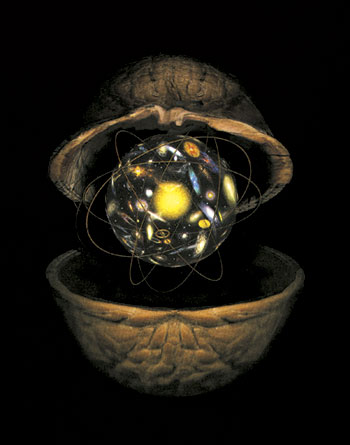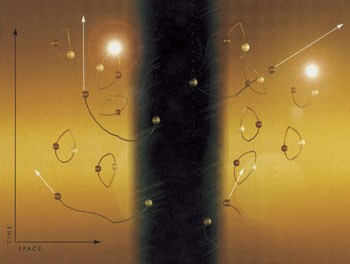
This Article From Issue
March-April 2002
Volume 90, Number 2
DOI: 10.1511/2002.10.0
The Universe in a Nutshell. Stephen Hawking. viii + 216 pp. Bantam Books, 2001. $35.
The Universe in a Nutshell is Stephen Hawking's second popular book. His first, A Brief History of Time, was more than a publishing phenomenon. It launched Hawking into the universe of cultural icons. Before the success of the book, no one could have imagined that a living scientist would share a television screen with the likes of Commander Data in an episode of "Star Trek" or Homer Simpson in an episode of "The Simpsons." Millions of people throughout the world have since come to recognize the synthesized voice of Hawking as the voice of scientific authority.
For years after A Brief History of Time was published, on airplanes, at cocktail parties and in health clubs, the revelation that you were a cosmologist invariably led to questions about Hawking and his book. I was always amazed by the number of people who claimed to have bought it without reading it or to have read it without understanding it, and was even more astounded that their admitted lack of comprehension did not in any way dampen their enthusiasm for the book. In fact, part of the popular cachet of the book seemed to be that it was beyond comprehension.

From The Universe in a Nutshell.
A Brief History of Time was an unlikely candidate for a bestseller. It was as if a low-budget, black-and-white college film project had suddenly become a blockbuster movie. The book seemed to violate conventional wisdom regarding what is necessary for popular success. The original edition was a decidedly old-fashioned basic product. It did not have pretty color pictures or fancy graphics. It was written in a linear fashion as one might write a science textbook. If you couldn't get through Chapter 2, then don't bother with Chapter 3. There were no sidebars or glitzy diagrams. Why was it such a phenomenal success? Perhaps Hawking discovered that all you really need for success is to tell a great story with authority, style, conviction, passion and a sense of humor.
If A Brief History of Time can be compared to a low-budget college film project, then The Universe in a Nutshell is more like a Hollywood mega-spectacle. The book is packed with color pictures, glossy diagrams, cartoons, sidebars, boxes and the like. In fact, only 6 of the book's 216 pages are just text; the remainder have some sort of color illustration, table or diagram. Some of the illustrations are very well done and very necessary to visualize complex geometrical things like curved space or wormholes, but occasionally I found some of the artwork superfluous and distracting. Although at times it is unclear whether the overwhelming amount of special effects adds to or subtracts from the flow, the narrative is always sufficiently forceful and compelling to carry the reader through.

From The Universe in a Nutshell.
The extensive "special effects" might have overshadowed a lesser personality, but Hawking manages to shine through the glitter. If authority, style, conviction, passion and a sense of humor were the secrets to his previous effort, Hawking's latest will succeed as well. As scientists we are trained to be careful to state only what we have observed or calculated, to limit speculation and conjecture, and, above all, to avoid unfounded personal opinions in scientific publications. Perhaps this style is ill-suited for popular writing. Hawking certainly does not hesitate to offer opinions and conjectures in his popular books. Apparently he feels that professors should profess something.
The structure of The Universe in a Nutshell is unlike that of a typical science text: After reading the first two chapters ("A Brief History of Relativity" and "The Shape of Time"), the reader is invited to navigate independently through the remaining five chapters. This is a real advantage, because few readers will follow everything in the book. If the Feynman path integral formulation of quantum mechanics and the Hartle-Hawking no-boundary proposal in Chapter 3 ("The Universe in a Nutshell") confuses the reader, then he or she might just skip ahead to the next chapter ("Predicting the Future") to learn about the fate of the information that may or may not disappear behind a black-hole horizon.
If a reader for some reason is not interested in future predictions, then it is possible to skip to Chapter 5 ("Protecting the Past") and learn of naked singularities, closed time-like curves and the possibility of traveling back in time to meet your ancestors. Perhaps some readers will become alarmed about the possibility that one of his or her descendants, dissatisfied with the reader's contribution to the gene pool, will travel to the past in order to prevent the contribution. Then the reader can either buy into the "chronology protection conjecture" championed by Hawking, which would prevent time travel, or just jump ahead to Chapter 6 ("Our Future? Star Trek or Not"). Chapter 6 differs from the rest in that it is not based on modern physics; rather, it is an essay on the future of the evolution of the human race. Although Hawking the futurist has not had the impact of Hawking the physicist, he still speculates with authority on complexity, extraterrestrials, evolution and genetically improved humans. This chapter truly is independent of other material in the book and can be read even without the preparation of the first two chapters. Finally, a reader really anxious for a taste of the hottest research in physics can just turn to the final chapter "Brane New World" and read of the latest conjectures about M-theory and large extra spatial dimensions.
The Universe in a Nutshell is written with the same exuberance as A Brief History of Time. Few scientists would have the courage to take a lay audience across the entire sweep of modern relativity and theoretical particle physics in a 200-page book. The scope of the book is as vast as its subject, covering subjects such as p-branes, warped spacetime, black holes, closed time-like loops, curved spacetime, dualities, event horizons, Grassman dimensions, vacuum fluctuations, "hidden variable" theories, imaginary time, Gödel's theorem, inflation, no-boundary condition, spacetime singularities, M-theory and supersymmetry. It is not easy reading. Any one of those topics could easily be expanded to fill a book. To cover such an enormous area Hawking usually employs a broad brush, but even with the absence of details the reader is able to appreciate the grandeur of the landscape.
In A Brief History of Time, Hawking wrote that if scientists really understood the workings of the universe, then they should be able to explain it in sufficiently simple terms so that the broad principles and concepts would be understandable to everyone. The Universe in a Nutshell is the best effort to date to explain the principles and concepts of our present understanding of the universe. The book may not be understandable to everyone, but then, scientists don't really understand the universe.
American Scientist Comments and Discussion
To discuss our articles or comment on them, please share them and tag American Scientist on social media platforms. Here are links to our profiles on Twitter, Facebook, and LinkedIn.
If we re-share your post, we will moderate comments/discussion following our comments policy.